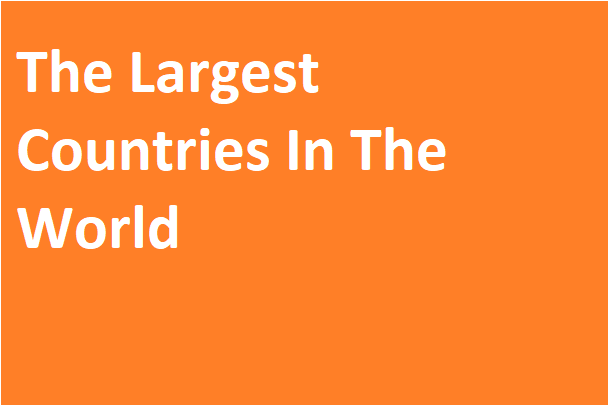The Largest Countries In The World
From Cape Horn to the Arctic Circle, the world’s largest countries provide a stunning snapshot of the variety of geography, climate and wildlife on the planet. Collectively, the world’s largest countries contain rainforest and tundra, mountains and valleys, coastline and desert.
As we explore the largest countries, we visit five different continents, some of the world’s most spectacular geography, and every type of climate imaginable.
Excitingly, it’s also always changing: history has shown that geopolitical boundaries change dramatically as the centuries go by. Which countries will become the largest in the world in the coming decades?
When 11.5 percent of all land in the entire world is claimed by only one country, it is not surprising to learn that the tenth largest country (Algeria) could fit into the largest (Russia) seven times. When all 10 of the largest countries in the world are taken together, they total 49% of the entire 149 million square kilometers of Earth’s land.

10-Algeria
The Algerian Sahara, the largest expanse of the Sahara Desert.
With 2.38 million square kilometers, Algeria is the tenth country in the world by region and the only African country in the top 10.
Algeria, located in North Africa, has a coastline of the Mediterranean Sea 998 km long. 90 percent of the country is desert, and many of the desert areas are very high. The Tell Atlas Mountains run along the northern border of the country, while the interior, largely hundreds of meters above sea level, contains the Algerian part of the Sahara desert. The massive Algerian Sahara extends all the way to the south of the country along the border with Niger and Mali.
9-Kazakhstan
Kazakhstan is the world’s largest landlocked country.
2.72 million square kilometers of Kazakhstan stretches across vast plains and Highlands. A cool and dry, but not entirely desert-like climate prevails most of the year. Kazakhstan has a great year-round temperature range, although it doesn’t get as cold in Kazakhstan as it does in parts of its northern neighbor, Russia.
Formerly part of the Soviet Union, the largest country in the world for most of the 20th century, Kazakhstan is currently the largest claim to fame as the largest landlocked country in the world-and the only landlocked country in the top 10.
8-Argentina
Mount Fitz Roy in Patagonia, Argentina.
Argentina, the world’s 32nd most populous country, is the world’s eighth largest, and the largest Spanish-speaking nation in the world by area. The 2.78 million square kilometers contain some of the most diverse geography and climate in the world.
Swampy, tropical conditions in the far north give way to icy glacial areas in the south. One of the most spectacular and dangerous places on earth, Patagonia stretches from the southern Andes in the west to the Atlantic Ocean in the East. The southern tip of Argentina, known as Cape Horn, is one of the most Stormy locations in the world.
7-India
India is the second largest state in terms of population and the seventh country in terms of area
India’s borders have changed quite a bit over the past century, and even still India claims that the Northern Region of Kashmir (an area disputed with Pakistan) is completely under Indian control. In its current state, excluding Kashmir, the Indian territory extends over 3.29 million square kilometers.
China, Pakistan, Bangladesh and Nepal each share a border with India and the geography ranges from the majestic Himalayas to the tropical shores of the southern peninsula. Geologically, India is found on its own subcontinent, and geological studies show that this entire nation and its closest neighbors were once separated from Asia by a sea.
6-Australia
The Twelve Apostles, Victoria State, Australia
The approximately 4.4 million square kilometre difference between Australia and India represents the second largest difference in size between countries ranked consecutively in the top 10. Australia, at around 7.69 million square kilometres, is more than twice the size of India.
It is by far the largest country in Oceania. Technically, it is so large that it does not even qualify as an island, it is a continental landmass.
The vast majority of the population lives in coastal cities like Sydney in the east and Perth in the west, and for good reason: the Australian outback is one of the world’s driest and hottest regions. along with extreme climate and geography, Australia is known for its spectacular – and often deadly – wildlife.
5-Brazil
Copacabana Beach, Rio de Janeiro, Brazil
The largest country in South America with more than 8.51 million square kilometers, Brazil is home to much of the world’s largest rainforest, the Amazon. The Amazon is so dense and vast that explorers and scientists have found human civilizations that had never made contact with the outside world.
Brazil also has a long Atlantic coastline on the eastern side, covering about 8,000 km. Most of its major cities, including Rio de Janeiro and São Paulo, are located on the coast.
4-People’s Republic Of China
The Great Wall of China stretches along a long strip of China’s northern border.
China, the United States and Canada each occupy almost seven percent of the earth’s surface. Of these three, China is the smallest – barely barely – at about 9.6 million square kilometers. It shares a border with 14 different countries, including Afghanistan to the East, Russia to the north, and Vietnam to the south. It is the largest country entirely in Asia.
The climate and people vary greatly. In the north, temperatures drop to subarctic levels, the center of the nation contains the Gobi, the world’s 4th largest desert, and in the south, temperatures regularly reach tropical levels. With more than 1.35 billion citizens, China is home to 56 recognized ethnic groups, has the world’s 18th largest Muslim population, the 19th largest Christian population, and with 1.9 doctors per 1000 people, China has more doctors than the entire population of Qatar.
3-United States of America
Long winding rivers of North Dakota cut across plains and canyons.
The United States, just larger than China but slightly smaller than Canada, occupies 9.63 million square kilometers. Bordered by Mexico to the south and Canada to the north, the United States offers a diverse range of geography and Wildlife.
Two north-south features split the nation into three distinct pieces. West of the Rocky Mountains, the Pacific states are known for year-round temperate weather and long expansive beaches along the California coast. Sandwiched between the Rockies and the Mississippi River, The Great Plains stretch from Canada to Mexico, making the United States one of the world’s most fertile growing regions. Finally, the third of the Nation east of the Mississippi is the industrial and economic center of America, with large cities scattered along the east coast.
2-Canada
Canada’s vast wilderness is popular for outdoor activities.
With Canada’s 9.984 million square kilometers, This is the largest country in the Western Hemisphere, and thanks to its 202,080 kilometers of coastline, it has a longer coastline than any other country. With a population density of 4 people per square kilometre, this means that each of Canada’s 35 million inhabitants could have 61 acres to themselves.
Positioned between the Arctic and the United States, the massive frozen tundra extends into the Arctic Circle. Split equally with the U.S.; in the western half of the country, the Rocky Mountains run north – south, and prairies provide vast grain and canola growing areas. Eastern Canada is the traditional heart of the nation, with Toronto, Montreal and the national capital of Ottawa all located to the East.
1-Russia
The landscape of Siberia, Russia.
Russia’s 17.1 million square kilometers easily makes it the world’s largest by area. In fact, if Russia were to bite off 7 million square kilometers, it would still be the largest – and the cut off section would take seventh place in total!
Like China, Russia borders 14 different countries. Unlike China, none of Russia is tropical, although humid summers prevail in much of southern Russia. The Taiga, the world’s largest terrestrial biome, extends all the way from Eastern Canada into the vast majority of northern Russia. Massive oil reserves exist beneath Russia’s frozen forests and tundra; however, due to the cost and difficulty of extracting it, much of Russia’s oil wealth remains untapped.
1 Russia 17,098,242
2 Canada 9,984,670
3 United States 9,826,675
4 China 9,596,960
5 Brazil 8,514,877
6 Australia 7,741,220
7 India 3,287,263
8 Argentina 2,780,400
9 Kazakhstan 2,724,900
10 Algeria 2,381,741
11 Congo, Democratic Republic of the 2,344,858
12 Greenland (Denmark) 2,166,086
13 Saudi Arabia 2,149,690
14 Mexico 1,964,375
15 Indonesia 1,904,569
16 Sudan 1,861,484
17 Libya 1,759,540
18 Iran 1,648,195
19 Mongolia 1,564,116
20 Peru 1,285,216
21 Chad 1,284,000
22 Niger 1,267,000
23 Angola 1,246,700
24 Mali 1,240,192
25 South Africa 1,219,090
26 Colombia 1,138,910
27 Ethiopia 1,104,300
28 Bolivia 1,098,581
29 Mauritania 1,030,700
30 Egypt 1,001,450
31 Tanzania 947,300
32 Nigeria 923,768
33 Venezuela 912,050
34 Namibia 824,292
35 Mozambique 799,380
36 Pakistan 796,095
37 Turkey 783,562
38 Chile 756,102
39 Zambia 752,618
40 Burma 676,578
41 Afghanistan 652,230
42 South Sudan 644,329
43 France 643,801
44 Somalia 637,657
45 Central African Republic 622,984
46 Ukraine 603,550
47 Madagascar 587,041
48 Botswana 581,730
49 Kenya 580,367
50 Yemen 527,968

